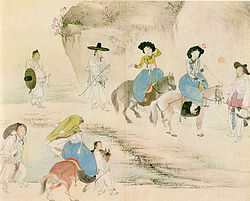Samjinnal
| Samjinnal | |
|---|---|
 "Yeonso dapcheong" drawn by Hyewon which depicts an outing in spring. | |
| Observed by | Koreans |
| Type | Cultural |
| Significance | Marks arrival of spring |
| Date | 3 March |
| Next time | 3 March 2014 |
| Related to | Shangsi Festival, Hinamatsuri |
| Samjinnal | |
| Hangul | 삼짇날 |
|---|---|
| Hanja | none |
| Revised Romanization | Samjinnal |
| McCune–Reischauer | Samchinnal |
Samjinnal is one of sesi pungsok (세시풍속) or Korean traditional customs by season, which falls on every March 3 in the lunar calendar. It was called samjil (삼질) in old Korean language and referred to as sangsa (상사, 上巳), wonsa (원사, 元巳), sungsam (중삼, 重三), sangje (상제, 上除) or dapcheongjeol (답청절, 踏靑節) in hanja. Samjinnal implies the overlapping of Sam (three). According to Choi Namseon, samjil was derived from the consonants of Samil, and Sangsa is defined as the first snake day of the 3rd lunar month.[1]
Customs
Samjinnal is the festive day that informs the arrival of spring. This day is known as the day the swallows came back from Gangnam and the day the snake came out from its winter sleep. It is also the day birds and butterflies start to appear. This day, in the North Gyeongsang region, seeing a snake signifies good luck, seeing a white butterfly means death that year, and seeing a yellow butterfly implies fortune. They say soybean paste brewed this day tastes especially good and houses are repaired. By conducting farm frugality, people pray for abundance.
During Samjinnal, people pick out azalea flowers and knead it with glutinous rice dough to make Hwajeon, a Korean traditional rice cake. Mung bean powder is used to make mung bean noodles, and is also occasionally used with the azalea flowers. By dyeing the mung bean powder with red water, a seasonal dish called Sumyeon can be prepared. Other than this, white bubble rice cakes made with red bean paste called Santteok, Goritteok made from glutinous rice, pine endodermis and mugwort, and Ssuktteok made from glutinous rice and mugwort leaves are eaten this day.
Nori (Folk games)
- Pulssaum (풀싸움)
- Pulgaksi noleum (풀각시놀음)
- Fortunetelling
- Hwajeon nori (화전놀이) - It literally means "flower pancake play".
See also
References
- "The Food on Samjinnal". Korea Agro-Fisheries Trade Corporation. Retrieved 2008-06-28.
- Chung, Hyeon-Mi (정현미). "(진달래 음식의 종류와 조리법 고찰) The Kind and Recipe of Korean Rosebay Food" (in Korean / English /Japanese). National Folk Museum of Korea. pp. 1–16p. Retrieved 2008-06-28.
- "전주전통문화센터, 모악산 대원사, 전주공예품전시관 삼짇날 축제" (in Korean). Jeonju Traditional Cultural Center. 2008-04-02. Retrieved 2008-06-28.
- "봄을 즐기는 ‘삼월 삼짇날’" (in Korean). miz.co.kr. Retrieved 2008-06-28.